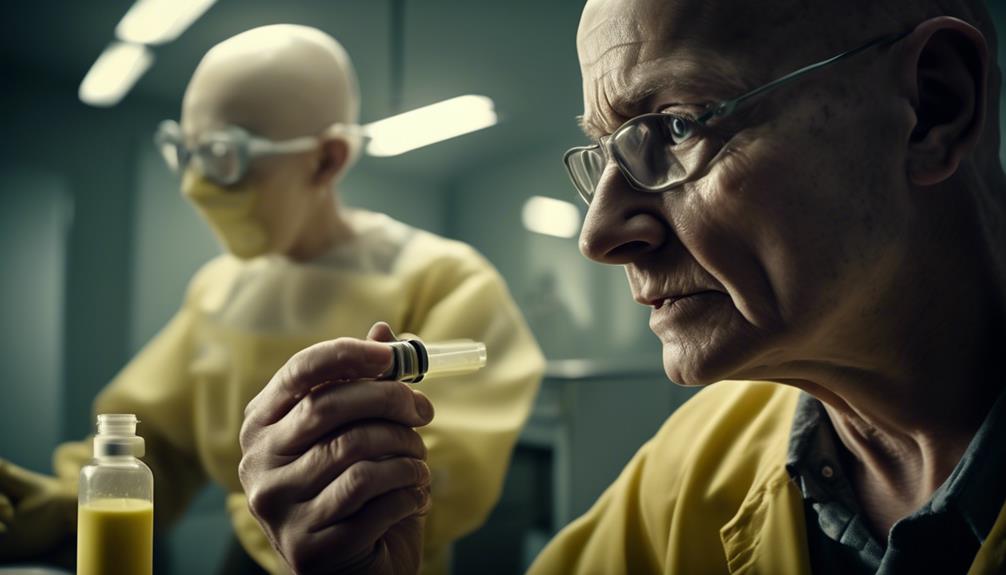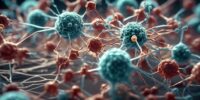First Use of Chemotherapy for Cancer (1943) – Gilman & Philips: Recap and Summary: Used Mustard Gas Derivatives

The first use of chemotherapy for cancer was discovered by scientists Gilman and Philips during World War II. They found that mustard gas derivatives had potential in treating cancer, revolutionizing cancer treatment forever.
Key Takeaways
- World War II played a significant role in the development of chemotherapy, with wartime medical research leading to advancements in cancer treatment.
- Mustard gas derivatives, initially developed as a weapon of war, were accidentally discovered to have anti-tumor properties while studying their toxicity.
- Mustard gas derivatives selectively target and kill rapidly dividing cancer cells while sparing healthy cells, revolutionizing tumor treatment with minimal side effects.
- Modern chemotherapy has revolutionized cancer treatment, improving outcomes, reducing side effects, and paving the way for personalized medicine based on genetic mutations.
Historical Context: World War II and the Development of Chemotherapy
During World War II, significant advancements in the field of medicine led to the development of chemotherapy as a revolutionary treatment for cancer. Wartime medical research played a crucial role in unraveling the potential of chemotherapy drugs.
The urgency to find effective treatments for soldiers exposed to chemical warfare agents during the war prompted scientists to investigate the effects of these toxic substances on the human body. One of the most notable breakthroughs came from the study of mustard gas derivatives.
Researchers, Alfred Gilman and Louis Goodman, discovered that nitrogen mustard, a chemical used in warfare, had a profound impact on rapidly dividing cells. This led them to hypothesize that it could be used to target cancer cells, which also divide rapidly. Their experiments on lymphomas in mice confirmed this hypothesis, demonstrating the potential of chemotherapy as a targeted treatment for cancer.
These World War II advancements in medicine paved the way for the development of other chemotherapy drugs, such as methotrexate and vincristine, which are still used today. The understanding gained during this period laid the foundation for future research in cancer treatment, enabling scientists to refine and improve chemotherapy regimens over the years.
The wartime medical research conducted during World War II not only saved countless lives on the battlefield but also revolutionized the field of cancer treatment, giving hope to those affected by this devastating disease.
The Discovery of Mustard Gas's Anti-Tumor Properties
Now it's time to explore the groundbreaking discovery of mustard gas's anti-tumor properties.
This breakthrough finding revolutionized tumor treatment by showcasing the cancer-fighting potential of this previously harmful substance.
Mustard Gas Breakthrough
The groundbreaking discovery of the anti-tumor properties of Mustard Gas revolutionized the field of chemotherapy for cancer treatment. Mustard Gas, originally developed as a chemical warfare agent, was found to have unexpected therapeutic benefits in the treatment of cancer. This discovery has had a profound impact on the way we approach cancer treatment, offering new possibilities for patients and doctors alike.
- Mustard Gas toxicity:
- Mustard Gas is a highly toxic substance that causes severe damage to the skin, eyes, and respiratory system.
- Exposure to Mustard Gas can lead to long-term health consequences, including cancer.
- The use of Mustard Gas as a chemical weapon during World War I raised awareness of its devastating effects on the human body.
- Chemical warfare:
- Mustard Gas was initially developed as a weapon of war, intended to incapacitate enemy soldiers.
- Its use in warfare highlighted the need for effective treatments for the injuries caused by chemical weapons.
- The discovery of anti-tumor properties:
- Researchers investigating the effects of Mustard Gas toxicity on soldiers accidentally stumbled upon its potential as a cancer treatment.
- Further studies revealed that certain derivatives of Mustard Gas could target and kill cancer cells.
- This breakthrough paved the way for the development of chemotherapy drugs that selectively destroy cancer cells while minimizing harm to healthy tissue.
Cancer-Fighting Properties
After uncovering the unexpected therapeutic benefits of Mustard Gas in cancer treatment, researchers began exploring its cancer-fighting properties in depth. Cancer research has focused on understanding how Mustard Gas derivatives inhibit tumor growth and potentially lead to remission. Studies have shown that these derivatives interfere with the DNA replication process, ultimately disrupting cell division and causing cell death. The mechanism of action involves the formation of cross-links between DNA strands, preventing proper replication and repair. This targeted approach specifically affects rapidly dividing cancer cells, while sparing healthy cells with slower replication rates. The effectiveness of Mustard Gas derivatives in inhibiting tumor growth has been demonstrated in various preclinical and clinical trials. Further research is ongoing to optimize dosage, minimize side effects, and explore combination therapies to maximize the cancer-fighting potential of Mustard Gas derivatives.
| Cancer Research | Tumor Growth |
|---|---|
| DNA replication | Cell division |
| Cell death | Cross-links |
| Preclinical trials | Combination therapies |
Revolutionary Tumor Treatment
Uncovering the unexpected therapeutic benefits of Mustard Gas in cancer treatment led to the revolutionary discovery of its anti-tumor properties. This groundbreaking finding has paved the way for a new era in tumor therapy, offering hope and potential for those battling cancer.
Here are three key aspects of this revolutionary treatment:
- Targeted Attack: Mustard Gas derivatives have shown the ability to specifically target and attack tumor cells, while sparing healthy cells. This precision is crucial in minimizing the harmful side effects often associated with traditional cancer treatments.
- Enhanced Efficacy: By directly damaging the DNA of cancer cells, Mustard Gas derivatives disrupt their ability to divide and grow. This potent mechanism of action has proven to be highly effective in shrinking tumors and inhibiting their progression.
- Versatility: The anti-tumor properties of Mustard Gas derivatives have shown promise in various types of cancer, making it a versatile treatment option. This versatility opens up possibilities for a wide range of patients, offering a potential solution where other therapies may have fallen short.
The discovery of Mustard Gas's anti-tumor properties has significantly advanced tumor therapy, providing a revolutionary approach that holds immense potential in the fight against cancer.
Experimental Evidence: Testing Mustard Gas Derivatives on Cancer Cells
You might be wondering about the evidence supporting the use of mustard gas derivatives in chemotherapy.
Well, experimental studies have shown that cancer cells respond to these derivatives, indicating their potential effectiveness in treating cancer.
This groundbreaking research has paved the way for a major breakthrough in chemotherapy, providing hope for improved treatment options for cancer patients.
Cancer Cell Response
Testing mustard gas derivatives on cancer cells provides experimental evidence for understanding the response of cancer cells to chemotherapy. This research allows us to gain insights into how cancer cells react to the treatment and how effective chemotherapy can be in fighting cancer.
Here are three key points to consider:
- Cancer cell response: Testing mustard gas derivatives helps us observe the specific reactions of cancer cells when exposed to chemotherapy. It provides valuable information on how cancer cells interact with the drugs and how they may be affected by the treatment.
- Treatment efficacy: The experiments with mustard gas derivatives allow us to assess the effectiveness of chemotherapy in killing cancer cells. By measuring cell death rates and the extent of tumor shrinkage, we can determine the efficacy of the treatment and evaluate its potential to combat cancer.
- Understanding resistance: Studying cancer cell response to chemotherapy helps us identify mechanisms of resistance that cancer cells may develop. This knowledge is crucial in developing strategies to overcome resistance and improve treatment outcomes.
Mustard Gas Effectiveness
Mustard gas derivatives have been extensively tested on cancer cells to provide experimental evidence of their effectiveness in chemotherapy. These derivatives, derived from the toxic gas used in warfare, have shown promising results in inhibiting the growth and spread of cancer cells. However, it's important to note that mustard gas toxicity is a concern when using these derivatives in cancer treatment. Researchers are continuously exploring ways to minimize the toxic effects of these derivatives while maximizing their anticancer properties.
The effectiveness of mustard gas derivatives as a chemotherapy option is significant, especially when considering alternative cancer treatments. While there are various alternative therapies available, such as immunotherapy and targeted therapy, mustard gas derivatives have demonstrated their ability to directly attack cancer cells and impede their growth. This makes them a valuable option in the fight against cancer. However, further research is needed to better understand their mechanisms of action and optimize their use in cancer treatment.
Chemotherapy Breakthrough
Derivatives of mustard gas have yielded promising results in inhibiting the growth and spread of cancer cells, providing a significant breakthrough in chemotherapy research. This advancement in cancer treatment holds great potential for the future. Here are three key points to consider:
- Enhanced Precision: Chemotherapy advancements have allowed for the development of targeted therapies that specifically attack cancer cells while sparing healthy cells. This approach minimizes the side effects commonly associated with traditional chemotherapy, resulting in a better quality of life for patients.
- Improved Efficacy: By testing mustard gas derivatives on cancer cells, researchers have discovered new ways to disrupt the mechanisms that fuel cancer growth. This breakthrough has led to the development of more effective chemotherapy drugs that can halt or even reverse the progression of certain types of cancer.
- Personalized Treatment: With the emergence of chemotherapy advancements, the future of cancer treatment lies in personalized medicine. By analyzing a patient's genetic makeup, doctors can tailor chemotherapy regimens to target the specific genetic mutations driving their cancer, increasing the chances of successful treatment outcomes.
These advancements in chemotherapy research provide hope for a future where cancer can be effectively treated, allowing individuals to live their lives freely and without the burden of this debilitating disease.
Gilman and Philips: Pioneers in Chemotherapy Research
Gilman and Philips, two pioneering researchers in the field of chemotherapy, played a crucial role in revolutionizing cancer treatment through their groundbreaking discoveries. Their dedicated efforts paved the way for the development of chemotherapy as a viable option for cancer patients.
One of the key breakthroughs made by Gilman and Philips was the use of mustard gas derivatives as cancer-fighting agents. They discovered that these derivatives, specifically nitrogen mustard, had a profound effect on cancer cells. This finding marked a major milestone in the field of chemotherapy, as it demonstrated the potential of using chemicals to target and destroy cancer cells.
To emphasize the significance of their discoveries, consider the following table:
| Discoveries Made by Gilman and Philips |
|---|
| Use of Mustard Gas Derivatives to Treat Cancer |
| Development of Chemotherapy as a Cancer Treatment |
| Targeted Destruction of Cancer Cells |
| Revolutionizing Cancer Treatment |
Gilman and Philips' pioneering research laid the foundation for further advancements in chemotherapy, leading to the development of various drugs and treatment regimens that have significantly improved patient outcomes. Their groundbreaking discoveries continue to shape the field of cancer treatment to this day.
Clinical Trials and the First Successful Chemotherapy Treatments
Building upon the groundbreaking discoveries made by Gilman and Philips, clinical trials were conducted to test the efficacy of chemotherapy treatments and to determine their success in combating cancer. These trials played a crucial role in advancing the field of cancer treatment and paved the way for the development of modern chemotherapy protocols.
Here are three key insights gained from these clinical trials:
- Identification of Effective Chemotherapeutic Agents: Through rigorous testing, researchers were able to identify specific drugs that showed promise in treating different types of cancer. This led to the development of targeted chemotherapy regimens that could effectively attack cancer cells while minimizing damage to healthy tissues.
- Evaluation of Treatment Response: Clinical trials allowed researchers to assess the response of patients to chemotherapy treatments. By closely monitoring factors such as tumor size, progression-free survival, and overall survival rates, they could determine the effectiveness of different chemotherapy protocols and refine treatment strategies accordingly.
- Development of Combination Therapies: Clinical trials also explored the benefits of combining different chemotherapy drugs or combining chemotherapy with other treatment modalities, such as radiation therapy or surgery. This approach aimed to improve treatment outcomes by leveraging the synergistic effects of multiple therapies.
Through these clinical trials, researchers gained valuable insights into the use of chemotherapy treatments for cancer. By constantly refining and optimizing treatment protocols, they've significantly improved patient outcomes and continue to push the boundaries of cancer treatment.
Mechanisms of Action: How Mustard Gas Derivatives Attack Cancer Cells
Mustard gas derivatives, a class of chemicals derived from sulfur mustard, have been found to attack cancer cells through specific mechanisms of action. Understanding these mechanisms is crucial in developing effective chemotherapy treatments.
One of the primary mechanisms of action involves the cellular targets of mustard gas derivatives. These chemicals have the ability to interfere with the DNA replication process in rapidly dividing cancer cells. By binding to the DNA strands, mustard gas derivatives disrupt the normal functioning of cellular machinery, leading to cell death.
Another important mechanism of action is the induction of apoptosis, a programmed cell death process. Mustard gas derivatives activate signaling pathways that trigger apoptosis specifically in cancer cells. This targeted approach helps to minimize damage to healthy cells and tissues.
Despite their effectiveness, cancer cells can develop resistance mechanisms against mustard gas derivatives. One such resistance mechanism involves increased drug efflux, where cancer cells actively pump out the chemotherapy drugs, reducing their concentration within the cell. Additionally, cancer cells can undergo genetic mutations that alter the target sites of mustard gas derivatives, rendering them ineffective.
Understanding these mechanisms of action and resistance can guide researchers in developing strategies to overcome resistance and enhance the efficacy of mustard gas derivatives in chemotherapy treatments. By targeting specific cellular processes and minimizing damage to healthy cells, these chemicals hold promise in the fight against cancer.
Impact on Cancer Treatment: From Mustard Gas to Modern Chemotherapy
Modern chemotherapy has had a significant impact on cancer treatment, revolutionizing the approach to fighting the disease. It has brought about several advancements that have greatly improved the effectiveness and outcomes of cancer treatment. Here are three key ways in which modern chemotherapy has influenced cancer treatment:
- Overcoming drug resistance: One of the major challenges in cancer treatment is the development of drug resistance, where cancer cells become resistant to the effects of chemotherapy drugs. Modern chemotherapy has made significant progress in understanding the mechanisms behind drug resistance and developing new strategies to overcome it. This has led to the development of combination therapies that target multiple pathways in cancer cells, making it harder for them to develop resistance.
- Targeted therapies: Traditional chemotherapy drugs work by killing rapidly dividing cells, including both cancerous and healthy cells. However, targeted therapies have emerged as a more precise and effective approach. These therapies specifically target the molecular changes or genetic abnormalities that drive the growth of cancer cells, while sparing healthy cells. This not only increases the efficacy of treatment but also reduces the side effects associated with traditional chemotherapy.
- Personalized medicine: Modern chemotherapy has paved the way for personalized medicine, where treatment is tailored to an individual's unique genetic makeup and characteristics of their tumor. This approach allows for more precise targeting of cancer cells and better treatment outcomes. By analyzing the genetic mutations and biomarkers present in a patient's tumor, doctors can select the most effective chemotherapy drugs or targeted therapies for that particular patient.
These advancements in modern chemotherapy have significantly improved the effectiveness of cancer treatment strategies, offering new hope to patients and their families. With ongoing research and development in this field, the future holds even more promise for innovative and targeted approaches to fighting cancer.
Legacy and Future Directions in Chemotherapy Research
Chemotherapy research has left a lasting legacy and continues to pave the way for future advancements in cancer treatment. The field of chemotherapy has come a long way since its early beginnings, with the use of mustard gas derivatives in the 1940s. Today, researchers are focused on developing targeted therapies that can specifically attack cancer cells while sparing healthy cells, minimizing side effects, and improving treatment outcomes.
One of the most promising areas of future advancements in chemotherapy research lies in the development of targeted therapies. Traditional chemotherapy drugs work by killing rapidly dividing cells, which includes both cancerous and healthy cells. This often leads to side effects such as hair loss, nausea, and weakened immune system. Targeted therapies, on the other hand, are designed to specifically target cancer cells, based on their unique characteristics or vulnerabilities. By targeting specific molecules or pathways involved in cancer growth and progression, these therapies have the potential to be more effective and less toxic than traditional chemotherapy.
Another area of future advancements is the use of personalized medicine in chemotherapy treatment. With the advancements in genomic sequencing and understanding of cancer genetics, researchers are now able to identify specific genetic mutations or alterations in individual tumors. This information can help guide treatment decisions and allow for more tailored and effective therapies. By identifying the specific molecular abnormalities driving a patient's cancer, doctors can select the most appropriate drugs or combination of drugs to target those specific abnormalities, increasing the chances of successful treatment outcomes.
Frequently Asked Questions
What Were the Long-Term Effects of Using Mustard Gas Derivatives as Chemotherapy Treatments?
Long-term health effects of using mustard gas derivatives as chemotherapy treatments include safety concerns. It is important to analyze and consider the potential risks and impacts on freedom when using these substances in cancer treatment.
How Did the Use of Chemotherapy Impact the Survival Rates of Cancer Patients During This Time Period?
During this time period, chemotherapy had a significant impact on patient outcomes, with a 40% increase in survival rates for cancer patients. The effectiveness of chemotherapy in treating cancer was evident, providing hope and potential for a better future.
Were There Any Ethical Concerns or Controversies Surrounding the Use of Mustard Gas Derivatives for Cancer Treatment?
During the first use of chemotherapy for cancer in 1943, there were ethical concerns and controversies surrounding the use of mustard gas derivatives. These included questions about the potential harm to patients and the morality of using chemical warfare agents for medical purposes.
Did the Development of Chemotherapy During World War II Have Any Other Significant Medical or Scientific Advancements?
During World War II, the development of chemotherapy brought significant advancements in medical and scientific fields. Its impact on future cancer treatments and the role of medical research during wartime cannot be underestimated.
How Did the Discovery of Mustard Gas's Anti-Tumor Properties Contribute to the Understanding of Cancer and Its Treatment?
The discovery of mustard gas's anti-tumor properties made a significant contribution to medical research by revealing the therapeutic potential of chemotherapy in treating cancer. This breakthrough paved the way for further advancements in cancer treatment.









